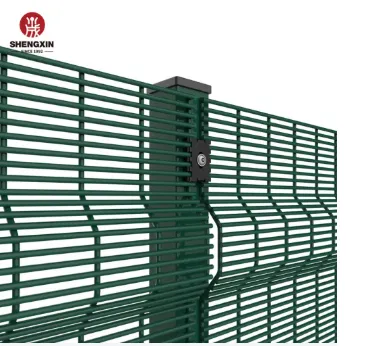
Փտր . 05, 2025 16:54 Վերադառնալ ցուցակին
Anti-Climb Fences: Essential Security Solutions for Protection
Anti-climb fences are designed to enhance security by preventing unauthorized access to protected areas. Widely used in high-security environments such as prisons, military bases, and industrial sites, these fences offer both physical and psychological barriers. In this article, we will explore the design, materials, and key benefits of anti-climb fences, highlighting why they are an essential element of any security system.

The Robust Design of 358 Anti Climb Fences
The 358 հակամագլցման պարիսպ, also known as a prison mesh fence, is one of the most popular choices for high-security locations. The name “358” comes from the dimensions of the mesh: 3 inches by 0.5 inches (76.2mm by 12.7mm) with 8 gauge wire, making it difficult for intruders to grip and climb over.
This design provides a strong barrier that is resistant to tampering, cutting, or climbing. The narrow mesh openings prevent hands and feet from finding purchase, which makes it an ideal solution for preventing unauthorized entry. The 358 հակամագլցման պարիսպ is typically used for applications where security is of the utmost importance, such as government buildings, airports, and utility plants.
Materials Used in Anti Climb Security Fences
The հակամագլցման անվտանգության պարիսպ is constructed from a variety of durable materials, each chosen to withstand different environmental conditions and security threats. Galvanized steel is commonly used for its strength and resistance to corrosion, ensuring that the fence remains functional and effective over time.
Some anti climb security fences also feature additional protective coatings, such as powder coating or PVC coating, to further enhance their resistance to weathering and vandalism. These coatings also improve the fence's appearance, making it suitable for areas that require a balance of aesthetics and security. In coastal areas or areas prone to high levels of moisture, stainless steel may be used for its superior corrosion resistance.
Enhanced Safety Features of Anti Climb Fences
One of the main benefits of an հակամագլցման պարիսպ is its ability to offer a high level of security while also preventing injuries. Unlike traditional fences with barbed wire, anti climb fences are designed to be safe for both employees and the public. The absence of sharp points or edges minimizes the risk of injury while still providing a strong deterrent to potential intruders.
Additionally, anti-climb fences are often paired with other security measures such as CCTV cameras, lighting, and motion sensors to create a comprehensive security system. These fences act as a deterrent, making it more difficult for potential intruders to gain access and increasing the likelihood of detection. The combination of physical and electronic security creates a powerful solution for protecting high-value assets.
The Psychological Impact of Anti Climb Security Fences
Beyond their physical function, anti-climb security fences serve as a psychological barrier for would-be intruders. The intimidating design, combined with its physical height and resistance to climbing, sends a clear message that entry is not only difficult but also highly likely to be detected. This visible deterrent can often prevent crime before it happens, as individuals will reconsider attempting to breach the fence when they understand the challenges involved.
For high-security locations such as prisons or military facilities, the psychological effect is just as important as the physical barrier. The sight of an հակամագլցման պարիսպ can deter trespassers from attempting to breach the area, as the fence communicates a sense of heightened security and control.
The Value of Anti Climb Fences in Modern Security
Anti-climb fences, such as the 358 հակամագլցման պարիսպ, play an integral role in modern security systems. Their robust design, durable materials, and added safety features make them a trusted solution for preventing unauthorized access. Whether used for government buildings, industrial sites, or high-security facilities, these fences offer a combination of physical and psychological deterrents that enhance overall protection.
Invest in an anti-climb security fence today to safeguard your property and ensure long-term security for your premises. Explore our range of customizable fencing options designed to meet your specific security needs.
-
Successful Applications of Double Wire Fences
ՆորություններJul.18,2025
-
Hot-Dipped Galvanized Steel Fence Post Base Plate
ՆորություններJul.18,2025
-
High-Quality Chain Link Temporary Fence
ՆորություններJul.18,2025
-
Customization Services for Curved 3D Wire Mesh Fences
ՆորություններJul.18,2025
-
Chain Link Fence Panels: Design and Customization
ՆորություններJul.18,2025
-
358 Anti-Climb Fence Security Solutions Guide
ՆորություններJul.18,2025
